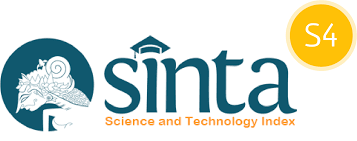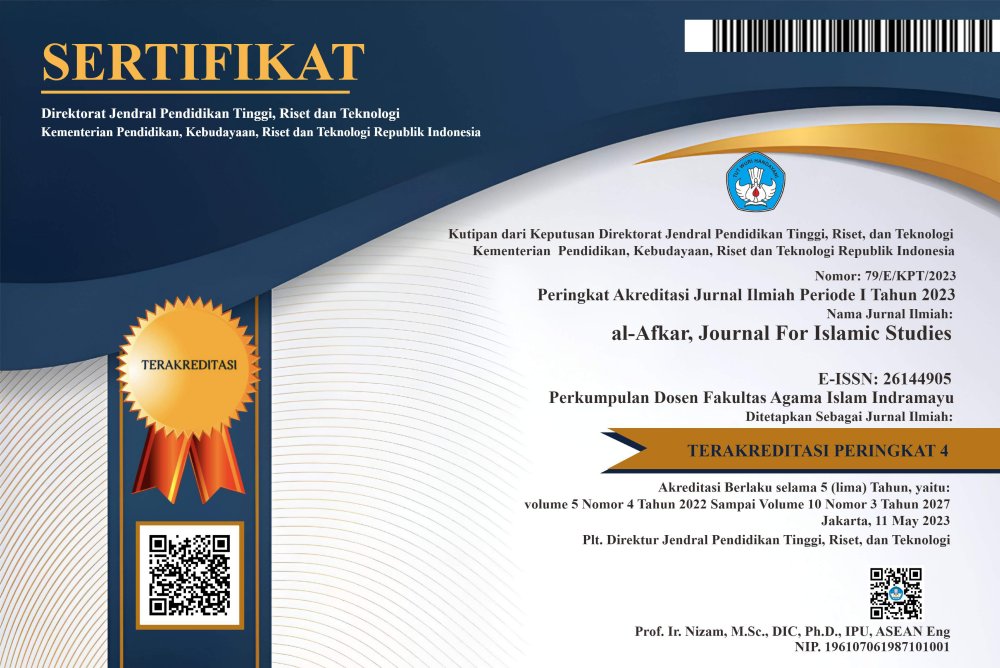Ibn Jarir Al-Thabari's Interpretation of the Word “Hurun In” in the Qur'an with a Linguistic Approach
DOI:
https://doi.org/10.31943/afkarjournal.v7i3.1163Keywords:
Qur'an, Hurun 'in, interpretation of Tafsir Ath-ThabariAbstract
Hurun 'in is a beauty that Allah promises to his servants as a pleasure for those who fear him. One of the pleasures that Allah promises to his servants, a companion in heaven, is the pure white angels with black eyeballs and beautiful eyes. A figure who has a beautiful nature and character that is always awake from goodness and beauty. The purpose of this study was to search for a broader meaning of the meaning of hurun 'in. In this study, the author uses the research method of tafsir maudhu'i by collecting verses in the Qur'an that have the same meaning. And then the author discusses with the tahlili method which refers to the book of tafsir ath-Tahabari by Abu Ja'far Muhammad bin Jarir Ath-Thabari. The results of this research in the view of Abu Ja'far Ath-Thabari the author found several meanings of hurun 'in his tafseer in interpreting the verses of hurun 'in.
Downloads
References
A’zom, Ismul. “PENAFSIRAN M QURAISH SHIHAB TERDAPAT HURUN IN DALAM TAFSIR AL- MISBAH,” 2019.
Abdoulaye, Bamba, Yahya Fathur Rozy, and Ahmadou Siendou Konate. “MUHAMMAD IBN ABDUL WAHHAB’S PERSPECTIVE ABOUT THE VERSES OF THE QUR’AN REGARDING THE SCIENCE OF THEOLOGY.” QiST: Journal of Quran and Tafseer Studies 3, no. 1 (December 2023): 57–74. https://doi.org/10.23917/qist.v3i1.2913.
Abulmajd, Abdurrahman. “WHAT IS THE MODEL OF MUSLIM RELATIONS WITH THE KAABA FROM THE PERSPECTIVE OF THE QUR’AN.” QiST: Journal of Quran and Tafseer Studies 3, no. 1 (December 2023): 107–45. https://doi.org/10.23917/qist.v3i1.3583.
Al-Jauziyyah, Ibnu al-Qayyim. “Tamasya Ke Syurga, Trans. Oleh Fadhli Bahrie.” Jakarta: Darul Falah, 2011, hlm. 337.
Alhaj, Ali Albashir Mohammed. “Exploring Syntactic and Cultural Problems Faced By Translators in Translating the Quranic Arabic Hope Word L-Amalu لَمَألْا in Surahs Al-Hijr and Al-Kahf Into English.” QiST: Journal of Quran and Tafseer Studies 2, no. 2 (2023): 116–33. https://doi.org/10.23917/qist.v2i2.1679.
Amhad Abdurraziq Al Bakri, Muhammad Adil Muhammad, Muhammad Abdul Lathif Khalaf, Mahmud Mursi Abdul Hamid. “Tafsir Ath Thabari Jami’ Al Bayan Fi Ta’wil Al Qur’an Terjemah Bahasa Indonesia Tahqiq.” In Tafsir Ath-Thabari, hal. 517-520. Pustaka Azzam, 2009.
AN, Andri Nirwana, Sufian Suri, Sayed Akhyar, Muhammad Amin, Syamsul Hidayat, and Didi Junaedi. “Exploration of Wasatiyah Diction to Realize Sustainable Tolerance Between Religious Communities: A Study of the Translation of the Quran of the Ministry of Religious Affairs of The Republic of Indonesia.” Journal of Law and Sustainable Development 11, no. 12 (December 2023): e2148. https://doi.org/10.55908/sdgs.v11i12.2148.
Anis, Muhammad Yunus, Mangatur Nababan, Riyadi Santosa, and Mohammad Masrukhi. “The Translation of Arabic Speech Act in Syarah Al-Hikam the Works of Muhammad Said Ramadhan Al-Buthi: Analysis of Spiritual Counselling Based on Pragmatic Equivalence.” Journal for the Study of Religions and Ideologies 21, no. 62 (2022): 70–83.
Arikunto, Suharsimi. ““Prosedur Penelitian Suatu Pendekatan Praktik” revisi,ke- (2010).
Asmendri, Milya Sari dan. “‘Penelitian Kepustakaan (Library Research) Dalam Penelitian Pendidikan IPA,.’” Natural Science: Jurnal Penelitian Bidang IPA Dan Pendidikan IPA 6 no. 1 (2020): 43-44.
Baqi, Muhammad Fuad ‘Abdul. Al- Mu’jam Al-Mufahras Li Alfaz AlQur’an Al-Karim. (Kairo: Dar al-Kutub al-Misriyyah,), 1945.
Hadi, M. Ishon El-Saha dan Saiful. Sketsa Al-Qur’an, Tempat, Tokoh, Nama Dan Istilah Dalam Al-Qur’an. (Lista Fariska Putra), 2005.
Hardianti, Mida. “‘Genealogi Model Penafsiran Bidadari Dalam AlQur’an,’” no. 1 (2020).
Hayyan, Abu. “Al Bahr Al Muhith” 10 (n.d.): 80–81.
Malia, Hayuni. “Analisis Makna Hurun ‘ In Dalam Al- Qur ’ an ( Kajian Teori Semiotika Roland Barthes ) A . Pendahuluan Narasi Tentang Kehidupan Di Surga Menjadi Salah Satu Pokok Pembicaraan Di Kalangan Umat Islam Terkait Alam Akhirat . Hal Itu Menyebabkan Tidak Sedikit U” 17, no. 2 (2023): 163–82. https://doi.org/10.24042/002023171556700.
Marthoenis, Marthoenis, Andri Nirwana, and Liza Fathiariani. “Prevalence and Determinants of Posttraumatic Stress in Adolescents Following an Earthquake.” Indian Journal of Psychiatry 61, no. 5 (2019): 526. https://doi.org/10.4103/psychiatry.IndianJPsychiatry_35_19.
Masduha. Al-Alfaazh - Buku Pintar Memahami Kata-Kata Dalam Al-Quran, 2017.
Misri, S. M. Al. “Surga, Menikahi Bidadari . Pustaks Al Inabah.” Al-Dzikra: Jurnal Studi Ilmu Al-Qur’an Dan Al-Hadits, 2018.
Muhammad Amin. “RELASI SOSIAL DALAM AL-QUR’AN.” QiST: Journal of Quran and Tafseer Studies Vol 1, Nom (2022): 33–34. https://doi.org/https://www.doi.org/10.23917/qist.v1i1.523.
Munandar, Siswoyo Aris, and Saifuddin Amin. “Contemporary Interpretation of Religious Moderation in the Qur’an: Thought Analysis Quraish Shihab and Its Relevance in the Indonesian Context.” QiST: Journal of Quran and Tafseer Studies 2, no. 3 (2023): 290–309. https://doi.org/10.23917/qist.v2i3.1448.
Parwanto, Wendi, and Engku Ahmad Zaki Engku Alwi. “The Pattern of Sufism on Interpretation of Q.S. Al-Fatihah in the Tafsir Manuscript By M. Basiuni Imran Sambas, West Kalimantan.” QiST: Journal of Quran and Tafseer Studies 2, no. 2 (2023): 163–79. https://doi.org/10.23917/qist.v2i2.1472.
Qadir, Faqihuddin Abdul. “Qira’ah Mubadalah: Tafsir Progresif Untuk Keadilan Gender Dalam IslamNo Title,” no. hal.312 (2019).
Ridha, Ismu, Manshur Mahmud Abu Zinah, Muhibbul Subhi, and M. Nasir. “THE QUR’AN’S STATEMENT ABOUT THE ETIQUETTE OF DEALING WITH THE HOLY QUR’AN FROM SAYYID QUTB’S PERSPECTIVE IN HIS INTERPRETATION OF (ADH-DHILAL): AN ANALYTICAL STUDY.” QiST: Journal of Quran and Tafseer Studies 3, no. 1 (December 2023): 40–56. https://doi.org/10.23917/qist.v3i1.2874.
Rochmah, Nur Hafifah, and Ahmad Munir. “INTERPRETATION OF THE QURAN WITH A PHILANTROPHIC APPROACH (TAFSIR AT-TANWIR STUDY BY MAJELIS TARJIH DAN TAJDID PP MUHAMMADIYAH).” QiST: Journal of Quran and Tafseer Studies 2, no. 3 (September 2023): 310–30. https://doi.org/10.23917/qist.v2i3.1903.
Rozy, Yahya Fathur, Yohei Matsuyama, and Dina Sijamhodžić-Nadarević. “THE DEVELOPMENT OF QUR’AN COMMENTATORS’ REQUIREMENTS: FROM THE AFFIRMATIVE ERA TO THE REFORMATIVE ERA.” QiST: Journal of Quran and Tafseer Studies 3, no. 1 (December 2023): 75–90. https://doi.org/10.23917/qist.v3i1.2910.
S Suharjianto, Rofi Atina Maghfiroh. “JAHILIYYAH DALAM PENAFSIRAN IBNU KASIR.” QiST: Journal of Quran and Tafseer Studies Vol. 1 No. (2022): 1925. https://doi.org/https://doi.org/10.23917/qist.v1i1.522.
Saprudin, Udin, J Junaedi, K Kerwanto, and Dito Anurogo. “LIMITING THE NUMBER OF POLYGAMIES TO REALIZE ECONOMIC JUSTICE: A HERMENEUTIC ANALYSIS OF MUHAMMAD SYAHRUR.” QiST: Journal of Quran and Tafseer Studies 2, no. 3 (September 2023): 347–68. https://doi.org/10.23917/qist.v2i3.2769.
Shihab, M. Quraish. “Afsir Al-Misbah: Kesan, Pesan, Dan Keserasian Al-Qur’an,” hlm. 535-537. Jakarta: Lentera Hati, 2002.
Subhan. “Al-Qur’an Dan Perempuan Menuju Kesetaraan Gender Dalam Penafsiran,” n.d., hlm. 63.
Sugiyono. “Metode Penelitian Manajemen.” ALFABETA, 2014.
Sule, Muhammad Maga. “RESPONSE TO MUSLIMS DA’WAH ACTIVITIES’ BY NON-MUSLIMS IN AKWANGA AND NASSARAWA EGGON LOCAL GOVERNMENT AREAS OF NASARAWA STATE, NIGERIA.” QiST: Journal of Quran and Tafseer Studies 3, no. 1 (December 2023): 23–39. https://doi.org/10.23917/qist.v3i1.3110.
Wadud, A. “Quran and Women, Membaca Kembali Kitab Suci Dengan Semangat Keadilan.” PT Serambi Ilmu Semesta., 2006.
Wadud, Amina. Qur’an Menurut Perempuan. (Jakarta: Serambi), 2001.
Yahya, Abdullah Muhammad, Moh Abdul Kholiq Hasan, and Andri Nirwana AN. “Rights Protection Guarantee for the Partners of Indonesian Gojek Company According to Labour Laws No 13 of 2033 and Maqasid.” Al-Manahij: Jurnal Kajian Hukum Islam 16, no. 1 (May 2022): 115–32. https://doi.org/10.24090/mnh.v16i1.6382.
Zaglul Fitrian Djalal. “TAFSIR PASE: (TELAAH ATAS METODOLOGI TAFSIR ACEH).” QiST: Journal of Quran and Tafseer Studies Vol 1, Nom (2022): 96–98. https://doi.org/https://doi.org/10.23917/qist.v1i1.527.
Downloads
Published
How to Cite
Issue
Section
License
Copyright (c) 2024 M.Agus, Andri Nirwana AN, Yeti Dahliana, Ahmad Nurrohim, Alfiyatul Azizah, Fuadi

This work is licensed under a Creative Commons Attribution 4.0 International License.



















